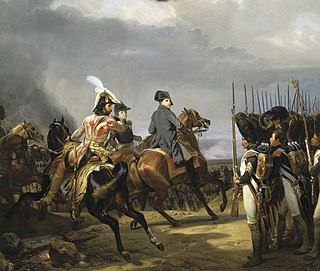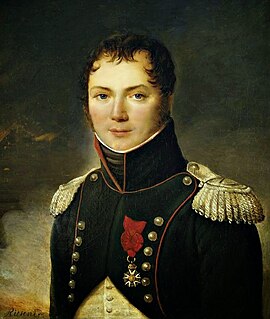La Grande Armée was the main military component of the French Imperial Army commanded by French Emperor Napoleon Bonaparte during the Napoleonic Wars. From 1804 to 1808, it won a series of military victories that allowed the French Empire to exercise unprecedented control over most of Europe. Widely acknowledged to be one of the greatest fighting forces ever assembled in history, it suffered enormous losses during the disastrous invasion of Russia in 1812, after which it never recovered its tactical superiority.

The Imperial Guard was originally a small group of elite soldiers of the French Army under the direct command of Napoleon I, but grew considerably over time. It acted as his bodyguard and tactical reserve, and he was careful of its use in battle. The Guard was divided into the staff, infantry, cavalry, and artillery regiments, as well as battalions of sappers and marines. The guard itself as a whole distinguished between the experienced veterans and less experienced members by being separated into three sections: the Old Guard, Middle Guard and Young Guard.
This is the complete order of battle of the French and Third Coalition armies during the Battle of Austerlitz.
This is an order of battle of the French and German Armies at the beginning of the Franco-Prussian War in 1870.

Étienne-Marie-Antoine Champion, comte de Nansouty was a French cavalry commander during the French Revolutionary Wars who rose to the rank of General of Division in 1803 and subsequently held important military commands during the Napoleonic Wars.

The Mounted Grenadiers of the Imperial Guard was a heavy cavalry regiment in the Consular, then Imperial Guard during the French Consulate and First French Empire respectively. They were the senior Old Guard cavalry regiment of the Imperial Guard and from 1806 were brigaded together with the Dragons de la Garde Impériale.

The armies of the First French Empire and the Austrian Empire fought the Battle of Caldiero from 29 to 31 October 1805 just east of Verona in Italy. Marshal André Masséna led the French Army of Italy while Archduke Charles commanded the Austrian Armee von Italien. Historians variously call the battle a French victory, an Austrian victory, or indecisive. Austrian losses were over 5,500, while the French suffered at least 5,000 casualties. Archduke Charles began a withdrawal from Italy on 1 November. The retreat ended in early December with Archduke Charles's army intact at Kormend in western Hungary. Unfortunately for Austria, by this time, Emperor Napoleon had decisively defeated the Austro-Russian army at the Battle of Austerlitz.

The Battle of Abensberg was fought on 20 April 1809, between an Allied force under the command of Emperor Napoleon I of France on one side and three Austrian corps led by Johann von Hiller, Archduke Louis of Austria, and Michael von Kienmayer. The Austrians formed the left wing of Archduke Charles, Duke of Teschen's main army and were under the overall command of Hiller. Napoleon's French troops, reinforced by troops from the Kingdom of Bavaria and the Kingdom of Württemberg outfought their opponents, inflicted heavy losses, and forced the Austrians to retreat to the southeast.
The Battle of Sacile saw the Franco-Italian Army of Italy commanded by Eugène de Beauharnais face the Archduke John of Austria's Army of Inner Austria during the War of the Fifth Coalition. Believing that he was only opposed by the Austrian VIII Armeekorps, Eugène launched his right wing in a heavy attack against it. In the morning, the Austrians successfully held off Franco-Italian assaults on their left flank as Eugène reinforced the attack with troops from his left wing. Later in the day, John counterattacked Eugène's weakened left wing with the IX Armeekorps, forcing the Franco-Italian army to withdraw from the battlefield. The battle at Sacile was preceded by the action of Pordenone on 15 April in which the Austrian advance guard mauled the French rear guard. The Austrian victory compelled Eugène to retreat to the Adige River at Verona where he gathered reinforcements and planned a counteroffensive.

Louis-Michel-Antoine, comte Sahuc, was a French army general born 7 January 1755 – died 24 October 1813, joined the French Royal Army and spent 20 years there before fighting in the French Revolutionary Wars. He rose to command a French cavalry regiment and later became a general officer. During the Napoleonic Wars he held important cavalry commands in three of Emperor Napoleon I of France's wars.

The Mounted Chasseurs of the Imperial Guard constituted a light cavalry regiment in the Consular, then Imperial Guard during the French Consulate and First French Empire respectively. They were the second senior "Old Guard" cavalry regiment of the Imperial Guard, after the Grenadiers à Cheval. The regiment had its origins in the Guides raised by General Bonaparte during his Italian Campaign of 1796. It was the Chasseurs that usually provided personal escort to Napoleon, and he often wore the uniform of the regiment in recognition of this service. The regiment was not only known for its lavish uniform, but its combat history as well.

The Jena-Auerstedt campaign order of battle is listed below. The order of battle includes units from the First French Empire and the Kingdom of Prussia that fought each other in the campaign that included the decisive Battle of Jena-Auerstedt on 14 October 1806. The order of battle may be useful to trace the battles of Schleiz and Saalfeld, which occurred before Jena-Auerstedt, as well as battles and capitulations that happened after 14 October, such as Erfurt, Halle, Prenzlau, Pasewalk, Stettin, Waren-Nossentin, and Lübeck.

The Army of Châlons was a French military formation that fought during the Franco-Prussian War of 1870. Formed in the camp of Châlons on August 17, 1870, from elements of the Army of the Rhine which the formation was issued from, the Army of Châlons was engaged in combats of Beaumont and Sedan while disappearing during the capitulation of September 2, 1870.
The Piave River 1809 order of battle shows the units and organization for the Franco-Italian and Austrian Empire armies that fought in the Battle of Piave River on 8 May 1809. Eugène de Beauharnais, the viceroy of the Kingdom of Italy defeated Archduke John of Austria. Eugène's Advance Guard crossed the river first and was assailed by Austrian cavalry and artillery. The French cavalry routed the opposing cavalry and captured 14 enemy guns. A lull followed as John arranged his infantry in a formidable defensive position. Meanwhile, Eugène struggled to pour reinforcements into the bridgehead as the Piave rose dangerously. In the afternoon, the viceroy sent Paul Grenier to drive back the Austrian left while Jacques MacDonald mounted an assault on the center. The attack succeeded in breaking the Austrian line and compelling John to order a retreat.
The II Cavalry Corps of the Grande Armée was a French military unit that existed during the Napoleonic Wars. It was first formed in December 1806, but only enjoyed a brief existence under Marshal Jean-Baptiste Bessières. The II Cavalry Corps was reconstituted for the invasion of Russia in 1812 and commanded by General Louis-Pierre Montbrun who was killed in battle, as was his successor a few hours later. During the War of the Sixth Coalition, General Horace François Bastien Sébastiani de La Porta led the II Cavalry Corps in 1813, while General Antoine-Louis Decrest de Saint-Germain led the corps in 1814. During the Hundred Days, Emperor Napoleon Bonaparte raised the corps again and entrusted it to General Rémi Joseph Isidore Exelmans.
The VII Corps of the Grande Armée was a French military unit that existed during the Napoleonic Wars. It was formed in 1805 and assigned to Marshal Pierre Augereau. From 1805 to 1807, Augereau led the VII Corps in the War of the Third Coalition and the War of the Fourth Coalition. It was disbanded after being nearly wiped out at the Battle of Eylau in February 1807 and its surviving troops were distributed to other corps.
The III Cavalry Corps of the Grande Armée was a French military unit that existed during the Napoleonic Wars. The corps was created in 1812 and reconstituted in 1813 and 1815. Emperor Napoleon Bonaparte first mobilized the corps for the invasion of Russia. Commanded by General Emmanuel de Grouchy, two divisions of the corps fought at Borodino, Tarutino, and Vyazma. A third division fought at the First and Second battles of Polotsk and the Berezina. During the War of the Sixth Coalition in 1813, General Jean-Toussaint Arrighi de Casanova led the corps at Großbeeren, Dennewitz, Leipzig, and Hanau.

The Army of the Rhine was created after the declaration of war on July 18, 1870. This French military unit fought in the Franco-Prussian War.

Charles Claude Jacquinot commanded a French cavalry division at the Battle of Waterloo in 1815. He joined a volunteer battalion in 1791 and transferred to a light cavalry regiment as a junior officer in 1793. He earned promotion to squadron commander and was acting commander of his regiment at Hohenlinden in 1800. After serving in a staff position at Austerlitz in 1805, he led a light cavalry regiment at Jena in 1806. Promoted to general of brigade he led his horsemen at Abensberg, Raab and Wagram in 1809. During the French invasion of Russia he fought at Ostrovno, Smolensk and Borodino in 1812. During the 1813 German Campaign he led a cavalry brigade at Dennewitz and Leipzig. After being appointed general of division he fought at Second Bar-sur-Aube and Saint-Dizier in 1814. During the Hundred Days he rallied to Napoleon and led a light cavalry division in the Waterloo campaign. After 15 years of inactivity, he was restored to favor in the 1830s. Thereafter he held a number of commands and was appointed to the Chamber of Peers. His surname is one of the names inscribed under the Arc de Triomphe, on Column 20.